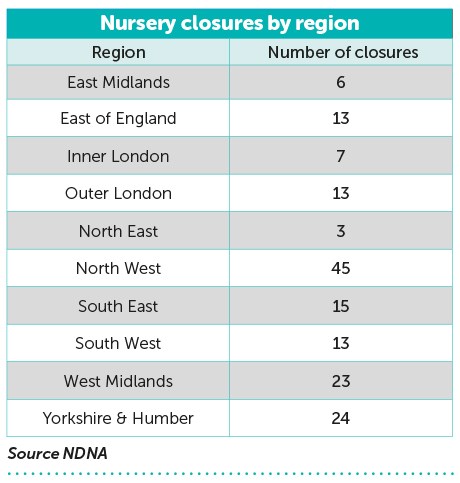Poor areas hit hardest by rising nursery closures
Catherine Gaunt
Thursday, September 12, 2019
More nurseries are closing in the most deprived areas of the country than elsewhere, according to analysis by the National Day Nurseries Association.

- More than a third of closures in the 30 per cent most deprived areas
- 7,250-plus children affected
The research shows that thousands of children and families have been affected by 185 nursery closures in the past 12 months.
More than a third of closures (35 per cent) recorded were in the 30 per cent most deprived areas of the country, while more than a quarter (28 per cent) were in the 20 per cent most deprived areas of England.
Almost half of the closures – 46 per cent – were in areas with the lowest funding rate from central Government of £4.30 an hour.
The vast majority (87 per cent) had a funding rate of less than £5 per hour.
Regional variations
The research, which is based on the NDNA’s membership data and from reports of closures gathered since September 2018, also reveals regional variations.
The highest number of closures were recorded in the North West, with 45 nurseries closing, followed by Yorkshire and Humber, with 24, and the West Midlands, with 23 closures.

Table note: Nurseries where postcode was unknown - 23
More than 7,250 children have been affected by their nursery closing since September 2018, the analysis shows.
While it is by no means an exhaustive list, the NDNA warns that the true figure for closures could be much higher.
This is the third year running that NDNA has collected data on closures and it shows that based on its figures, closures have risen by 153 per cent since September 2016, a year before the introduction of 30-hour childcare.
Purnima Tanuku, chief executive of NDNA, said, ‘It’s very upsetting when any nursery has to make the decision to close its doors. It can be heart-breaking for children and their families who have to try to find alternative arrangements.
‘Any break in their continuity of care can be damaging for children at a crucial stage of their development. It also has a knock-on effect on parents being able to work and leaves dedicated early years professionals searching for another job.’
The NDNA figures show that between:
- September 2016 to August 2017 there were 73 closures in England;
- from September 2017 to August 2018 there were 121 closures (up by 66 per cent),
- from September 2018 to August 2019 there were 185 closures (up by 153 per cent from September 2016).
Deprived areas
With this year’s data, the NDNA has mapped the closures against the Index of Multiple Deprivation.
Ms Tanuku added, ‘We have looked at where the closures are taking place and there’s a correlation between closures and low funding rates from central government to local authorities. It’s largely down to the Government not putting enough investment into this vote-winning policy for parents.
‘We’re also extremely concerned about the numbers of closures in areas of deprivation – these are areas where children could really benefit from having access to high quality early education to close the attainment gap.
‘These figures are only those we have managed to collate but we believe the true figure could be much higher.’
Around 35 per cent of nursery closures and 33 per cent of registered childcare places were lost in the 30 per cent most deprived areas of England.
In comparison, 14 per cent of nursery closures and 18 per cent of childcare places were lost in the 20 per cent most affluent areas of the country.
NDNA members and many other sources in the sector have long reported underfunding of the Government’s early years places.
The association says that there are now far more closures than before 30 hours began, and that any closure has a negative impact on the wider community and will affect children and their families even if it reopens in some form.
Ms Tanuku added, ‘After three years of stagnant funding as well as consistent pressure to address the challenges the sector faces the Chancellor has now promised to increase the hourly rates. However, we will wait to see the detail of where this additional money will go and for many early years settings and families it will come too late.
‘In addition to increasing the funding, an immediate measure that the Government could take is to exempt all nurseries from business rates to help them with sustainability. Business rates penalise nurseries for the space they give children to play, learn and grow. ‘
Governments in Scotland and Wales have recognised this and already offer nursery businesses 100 per cent rates relief.
While the NDNA said there cannot be a guarantee that nursery settings which have closed have not since been re-opened by new owners, its data is based on nurseries who have approached them for business support, reported financial difficulty or told them that they plan to close.
The analysis also includes publicly reported closures from national and local press. Registrations have then been checked with Ofsted registration data.




